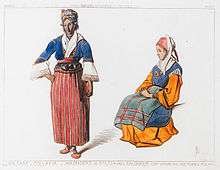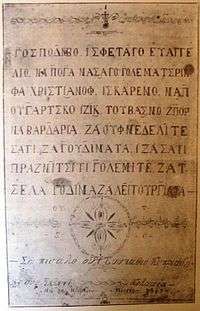Chalastra
| Chalastra Χαλάστρα | |
|---|---|
 Chalastra | |
|
Location within the regional unit  | |
| Coordinates: 40°38′N 22°44′E / 40.633°N 22.733°ECoordinates: 40°38′N 22°44′E / 40.633°N 22.733°E | |
| Country | Greece |
| Administrative region | Central Macedonia |
| Regional unit | Thessaloniki |
| Municipality | Delta |
| • Municipal unit | 121.415 km2 (46.879 sq mi) |
| Population (2011)[1] | |
| • Municipal unit | 9,859 |
| • Municipal unit density | 81/km2 (210/sq mi) |
| Community[1] | |
| • Population | 7,270 (2011) |
| • Area (km2) | 98.449 |
| Time zone | EET (UTC+2) |
| • Summer (DST) | EEST (UTC+3) |
Chalastra (Greek: Χαλάστρα) is a town and former municipality in the Thessaloniki regional unit, Greece. Before 1926, it was known as Κουλουκιά - Kouloukia (Bulgarian: Кулакия - Kulakiya). It was renamed to Chalastra in 1926, to Πύργος - Pyrgos in 1955 and back to Chalastra in 1980.[2] Since the local government reform of 2011 it has been part of the municipality Delta, of which it is a municipal unit.[3] The town is located 20 km west from the city of Thessaloniki, on the north side of Greek National Road 1, near the Axios river and the Thermaic Gulf. The municipal unit of Chalastra consists of the two communities of Chalastra itself and Anatoliko. The population was 9,859 inhabitants according to the 2011 census, most of them working in agriculture and small industry. The municipal unit Chalastra has an area of 121.415 km2, and the community Chalastra has an area of 98.449 km2.[4]
History


Chalastra (Greek: Χαλάστρα, Strabo vii.; Χαλέστρη, Herod. vii. 123; Χαλαίστρα, Plut. Alex. 49; Plin. iv. 10. § 17, xxxi. 10. § 46) was known as a town of Mygdonia in ancient Macedonia, situated on the Thermaikos gulf at the mouth of the Axios river, which belonged to the Thracians and possessed a harbor. (Steph. B. s.v.) A large part of the population was absorbed in Thessaloniki when it was founded by Cassander. Little remains of the original town, but it is considered that it was close to modern Kulakia.
References
- 1 2 "Απογραφή Πληθυσμού - Κατοικιών 2011. ΜΟΝΙΜΟΣ Πληθυσμός" (in Greek). Hellenic Statistical Authority.
- ↑ EETAA local government changes
- ↑ Kallikratis law Greece Ministry of Interior (Greek)
- ↑ "Population & housing census 2001 (incl. area and average elevation)" (PDF) (in Greek). National Statistical Service of Greece. Archived from the original (PDF) on 2015-09-21.
- ↑ Mazon, Andre et Andre Vaillant. L'evangeliaire de Kulakia un parler slave du Bas-Vardar, Paris 1938.
- ↑ Господново и сфетаго евангелио на бога нашаго голема црикфа христианоф, искарено на бугарцко изик тувашно збор на Вардариа за уф неделите сати за гудината и за сати празницити големите за цела година за литургиата. Са писало ут Евстатио Киприади уф селото Колакиа на 30 ноемврио месиц 1863.
 This article incorporates text from a publication now in the public domain: Smith, William, ed. (1854–1857). "article name needed". Dictionary of Greek and Roman Geography. London: John Murray.
This article incorporates text from a publication now in the public domain: Smith, William, ed. (1854–1857). "article name needed". Dictionary of Greek and Roman Geography. London: John Murray.